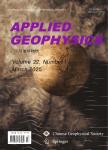版权所有:内蒙古大学图书馆 技术提供:维普资讯• 智图
内蒙古自治区呼和浩特市赛罕区大学西街235号 邮编: 010021

作者机构:中国地质大学地质过程与矿产资源国家重点实验室北京100083 中国地质大学地下信息探测技术与仪器教育部重点实验室北京100083 中国地质大学(北京)地球物理与信息技术学院北京100083 中国国土资源航空物探遥感中心北京10083 华东冶金地质勘查局812地质队铜陵244008
出 版 物:《Applied Geophysics》 (应用地球物理(英文版))
年 卷 期:2012年第9卷第1期
页 面:9-18,114页
核心收录:
学科分类:081801[工学-矿产普查与勘探] 081802[工学-地球探测与信息技术] 08[工学] 0818[工学-地质资源与地质工程]
基 金:supported by the National Hi-Tech Research and Development Program of China (863 Program) (No. 2007AA09Z310) National Natural Science Foundation of China (No. 40677037, 40774029, 41004028) Fundamental Research Funds for the Central Universities (No. 2010ZY53) Program for New Century Excellent Talents in University (NCET)
主 题:MT sparse lines 3D inversion impedance tensor tipper
摘 要:Currently, most of MT (magnetotelluric) data are still collected on sparse survey lines and interpreted using 2D inversion methods because of the field work cost, the work area environment, and so on. However, there are some 2D interpretation limitations of the MT data from 3D geoelectrical structures which always leads to wrong geological interpretations. In this paper, we used the 3D inversion method to interpret the MT sparse lines data. In model testing, the sparse lines data are the MT full information data generated from a test model and processed using the 3D conjugate gradients inversion code. The inversion results show that this inversion method is reasonable and effective. Meanwhile, we prove that for inversion results with different element parameters, the results by joint inversion of both the impedance tensor data and the tipper data are more accurate and closer to the test model.